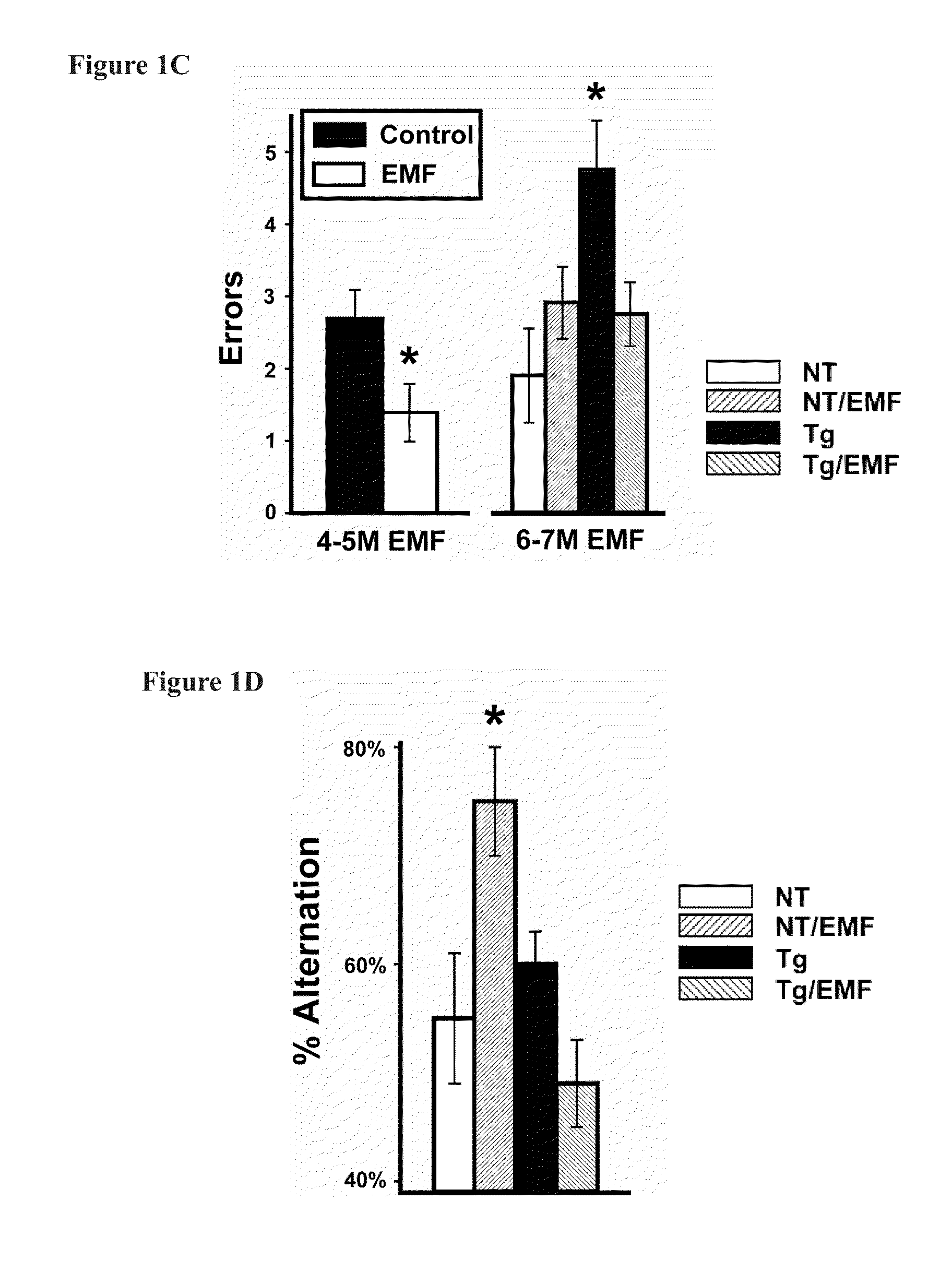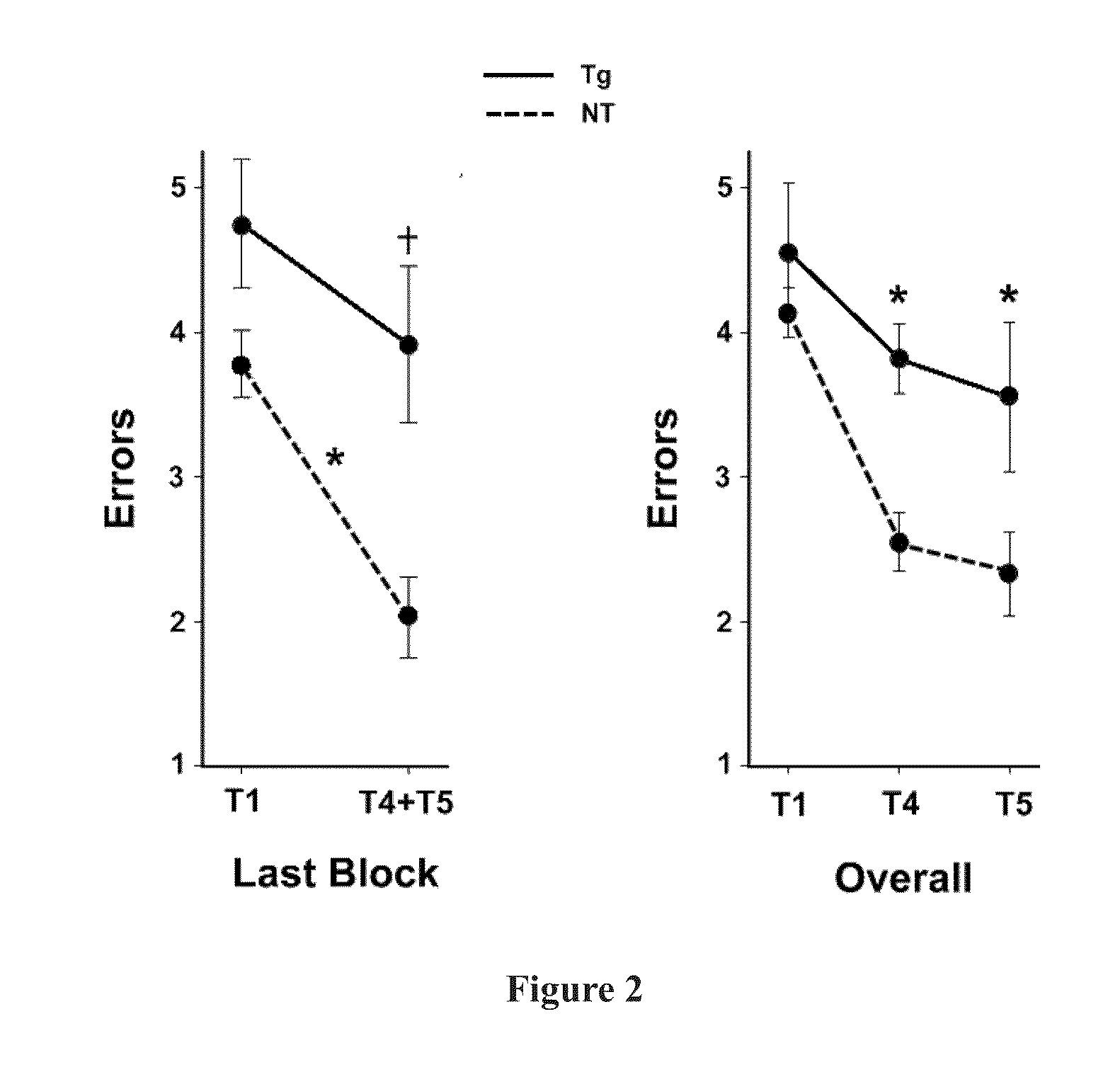Prevention and treatment of brain diseases and disorders related to abnormal protein aggregation through electromagnetic field treatment
a technology of abnormal protein aggregation and electromagnetic field treatment, which is applied in the direction of magnetotherapy using coils/electromagnets, microwave therapy, therapy, etc., can solve the problems of secondary brain injury, little data concerning the long-term effects of emf frequency on brain physiology and function, and the patients become even more cognitively impaired. , to achieve the effect of enhancing cognitive function
- Summary
- Abstract
- Description
- Claims
- Application Information
AI Technical Summary
Benefits of technology
Problems solved by technology
Method used
Image
Examples
example 1
Animals
[0056]A total of 96 mice, derived from the Florida Alzheimer's Disease Research Center's colony, were included in these studies. Each mouse had a mixed background of 56.25% C57, 12.5% B6, 18.75% SJL, and 12.5% Swiss-Webster. All mice were derived from a cross between heterozygous mice carrying the mutant APPK670N, M671L gene (APPsw) with heterozygous PS1 (Tg line 6.2) mice, which derived off-spring consisting of APP / PS1, APPsw, PS1, and non-transgenic (NT) genotypes. After weaning and genotyping, APPsw and NT mice were selected for behavioral studies, while temperature-monitoring studies also included APP / PS1 mice. All mice were maintained on a 12-hour dark and 12-hour light cycle with ad libitum access to rodent chow and water. All animal procedures were performed in AAALAC-certified facilities under protocols approved by the USF Institutional Animal Care and Use Committees.
example 2
Young Adult Long-Term Study
[0057]A total of 24 APPsw (Tg) mice and non-transgenic (NT) littermates, aged 2-2½ months, were divided into the following four groups: Tg controls, Tg+EMF, NT controls, NT+EMF (n=6 per group) All APPsw mice were screened for plasma Aβ levels and both Tg groups were balanced in terms of plasma Aβ levels. Tg and NT mice exposed to EMFs were housed in cages within a large Faraday cage, which also housed the antenna of an EMF generator providing two 1-hour periods of electromagnetic waves per day (early morning and late afternoon) within the ISM band frequency range of 902-928 MHz (typically 918 MHz), pulsed and modulated, 0,25-1.05 W / kg. At 6½ and at 9 months of age (4-5 and 6-7 months into EMF exposure), all mice were evaluated in a cognitive interference task (see Behavioral Test Protocols below) that closely parallels, and was designed from, a cognitive interference task utilized in humans to differentiate aged non-demented, MCI, and AD patients from one ...
example 3
Aged Adult Long-Term Study
[0060]At 4 months of age, Tg mice (n=12) and NT littermates (n=16) were first evaluated in the radial arm water maze (RAWM) task of working memory (see behavioral methodology) to establish that Tg mice were cognitively impaired prior to EMF exposure. Based on pre-treatment performance in the RAWM task and pre-treatment blood Aβ levels, Tg and NT groups were each divided into two balanced sub-groups as follows: Tg controls, Tg+EMF, NT controls, NT+EMF (n=5-8 mice / group). At 5 months of age, Tg and NT mice to be exposed to EMFs had their cages placed within a large Faraday cage, which contained an EMF generator antenna providing the same exposure of two 1-hour periods of electromagnetic waves per day within the ISM band frequency range of 902-928 MHz (typically 918 MHz), pulsed and modulated, 0.25-1.05 W / kg, as in the Young Adult study. At 7 months of age (2 months into EMF exposure), all mice were re-tested in the RAWM task. Then at 10 and 13 months of age (...
PUM
 Login to View More
Login to View More Abstract
Description
Claims
Application Information
 Login to View More
Login to View More - R&D
- Intellectual Property
- Life Sciences
- Materials
- Tech Scout
- Unparalleled Data Quality
- Higher Quality Content
- 60% Fewer Hallucinations
Browse by: Latest US Patents, China's latest patents, Technical Efficacy Thesaurus, Application Domain, Technology Topic, Popular Technical Reports.
© 2025 PatSnap. All rights reserved.Legal|Privacy policy|Modern Slavery Act Transparency Statement|Sitemap|About US| Contact US: help@patsnap.com



